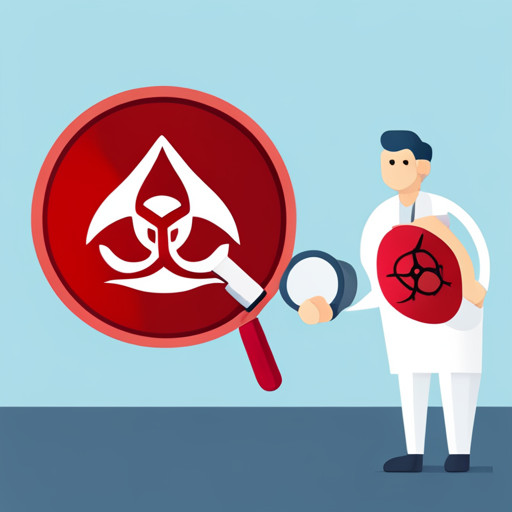Steps to Take if Suspecting Leukemia From Tainted Water
Ironically, water, the essence of life, can sometimes be a harbinger of deadly diseases like leukemia. This article discusses the suspected link between leukemia and contaminated water, highlighting symptoms, diagnostic processes, and the importance of immediate medical consultation.

Furthermore, it explores legal rights, compensation for victims, and the significance of ensuring clean water supplies. The objective is to guide individuals suspecting leukemia due to tainted water through their journey from suspicion to confirmation and litigation.
Key Takeaways
- Recognize the early signs of leukemia, such as fatigue, fever, and unexplained weight loss, which may be mistaken for common illnesses.
- Seek prompt medical consultation if persistent symptoms are present, especially in areas with water contamination issues.
- Understand the importance of effective doctor-patient communication in the diagnosis and treatment of leukemia.
- Follow the diagnostic process, which includes physical examination, medical history, blood tests, bone marrow tests, and imaging tests, to confirm or rule out leukemia and determine its type and stage.
Understanding the Link Between Leukemia and Contaminated Water

A comprehensive examination of current scientific literature reveals an undeniable correlation between leukemia occurrence and consistent ingestion of water contaminated with carcinogenic substances. This correlation is primarily due to the presence of waterborne carcinogens in the water supply, which have been linked to a variety of health issues, including leukemia.
Environmental toxins, often originating from industrial waste, agricultural runoff, and natural geological formations, are a major contributor to water contamination. These toxins include known carcinogens such as arsenic, radon, and chromium-6. When ingested regularly, these substances can cause damage to the DNA in cells, which can lead to the development of leukemia.
Studies have also shown that children are particularly susceptible to leukemia caused by waterborne carcinogens. This is primarily due to their developing immune systems and the fact that they consume more water per pound of body weight than adults. Moreover, the latency period between exposure to these carcinogens and the onset of leukemia can often span several years, making it difficult to establish a direct causal relationship in many cases.
Recognizing Early Symptoms of Leukemia

Early signs of this malignancy often include fatigue, fever, and unexplained weight loss, which necessitate prompt medical attention. The onset of these symptoms may be gradual and subtle, often mistaken for signs of common illnesses. However, the persistence of these symptoms should raise suspicion of a more serious condition like leukemia. This becomes particularly significant in areas with a known issue of contaminated water, where the prevalence of leukemia may be higher.
Leukemia risk factors are diverse and may vary among individuals. Genetic predisposition is one of the major contributory elements. It was found that individuals with certain genetic abnormalities are at a higher risk of developing this malignancy. Exposure to certain environmental factors, such as radiation and certain chemicals, has also been linked to the development of leukemia.
When suspecting leukemia, three significant steps should be considered:
1. Consult a healthcare professional immediately: Timely medical attention can aid early diagnosis, increasing the effectiveness of treatment strategies.
2. Request a complete blood count test: This test can detect abnormal levels of white blood cells, which may suggest leukemia.
3. Genetic testing: If there is a known family history of leukemia, genetic testing can help determine an individual's risk.
The Importance of Immediate Medical Consultation

Prompt medical consultation plays a pivotal role in diagnosing serious medical conditions such as leukemia, especially in regions with known water contamination issues. It is crucial for individuals experiencing symptoms associated with this disease to seek immediate medical attention. Consultation benefits are manifold, including early diagnosis, the initiation of appropriate treatment, and the provision of necessary health education.
Doctor-patient communication can significantly influence the effectiveness of the consultation process. Effective communication allows for an accurate and comprehensive understanding of the patient's symptoms, thereby enabling a more precise diagnosis. Moreover, clear and open communication provides a platform for the patient to voice concerns, ask questions, and gain a better understanding of their health condition.
The table below summarizes the importance of prompt medical consultation and effective doctor-patient communication:
| Consultation Benefits | Doctor-Patient Communication |
|---|---|
| Early Diagnosis | Enables Comprehensive Understanding of Symptoms |
| Initiation of Appropriate Treatment | Provides Platform for Patient to Voice Concerns |
| Provision of Necessary Health Education | Facilitates Better Understanding of Health Condition |
Steps to Confirm Your Suspicions: The Diagnostic Process

Understanding the diagnostic process can help individuals navigate their healthcare journey, particularly when they are dealing with potential health risks associated with water contamination. This process often involves a myriad of tests and procedures that aim to provide a clear picture of an individual's health status.
In the context of leukemia, which may be suspected due to exposure to tainted water, the diagnostic process is particularly important. This is due to the fact that early detection can significantly influence disease progression timelines and necessitate lifestyle adjustments.
The initial step in the diagnostic process typically involves a physical examination and a detailed medical history. These provide valuable insights into an individual's health status and potential risk factors. Blood tests, such as complete blood count (CBC) and blood smear tests, are also commonly conducted.
There are specific steps in the diagnostic process for suspected leukemia, which are as follows:
1. Bone Marrow Test: This test involves the extraction of a small amount of bone marrow, usually from the hip bone, which is then analyzed for leukemia cells.
2. Lumbar Puncture: Also known as a spinal tap, this procedure involves collecting a sample of cerebrospinal fluid to check for leukemia cells.
3. Imaging Tests: Techniques such as X-rays, CT scans, or MRI can be used to check for signs of leukemia in other parts of the body.
This process not only confirms or rules out the diagnosis but also provides crucial information on the type and stage of leukemia, if present. Such a diagnosis can greatly impact disease progression timelines and necessitate significant lifestyle adjustments.
What to Expect From Leukemia Blood Tests

Critical insights into the presence and progression of leukemia can be obtained from specific blood tests, which form a key component in the diagnostic process. Blood tests are designed to measure various components of the blood, providing valuable data regarding the overall health status of an individual, while also offering clues to any abnormalities.
Genetic predisposition plays a significant role in the onset of leukemia. Certain genetic mutations may increase the risk of developing this disease. Lifestyle influences, such as exposure to hazardous chemicals or radiation, can also contribute to the development of leukemia. It is noteworthy to consider both these factors when interpreting blood test results.
Blood tests that are typically performed when leukemia is suspected include complete blood count (CBC), blood smear, and bone marrow test. Each of these tests serves a unique purpose and provides distinct information about the condition of the blood cells.
| Test | Purpose |
| Complete Blood Count (CBC) | Measures the number and types of cells in the blood. |
| Blood Smear | Examines the appearance of blood cells under a microscope. |
| Bone Marrow Test | Checks for leukemia cells in the bone marrow. |
These tests provide a comprehensive view of blood health, aiding in the detection, classification, and monitoring of leukemia. They also help in understanding the potential risks and determining the most effective treatment plan. It is essential to remember that the results of these tests should be interpreted in conjunction with clinical symptoms and medical history for a complete and accurate diagnosis.
Insights Into Bone Marrow Biopsy for Leukemia Detection

The subsequent discussion delves into the intricacies of the bone marrow biopsy procedure, a crucial diagnostic tool for the detection of leukemia.
This investigation elucidates the detailed methodology of the procedure, providing an overview of the steps involved, the risks associated, and the critical role it plays in the diagnosis.
Furthermore, the discourse will extend to the interpretation of biopsy results, offering insight into how medical professionals decipher these findings to confirm or rule out leukemia.
Bone Marrow Biopsy Procedure
Bone marrow biopsy procedure involves a medical professional extracting a small sample of the bone marrow tissue for further laboratory analysis to confirm a diagnosis of leukemia. However, alternatives to this invasive method exist.
1. Peripheral Blood Smear: This is a non-invasive alternative, where a blood sample is checked for the presence of abnormal cells.
2. Flow Cytometry: This test is used to examine the cells in a person's blood and marrow, providing a detailed image of the cells.
3. Imaging Tests: Techniques such as X-rays, CT scans, or ultrasounds can be used to detect leukemia.
Pain management during a biopsy involves local anesthesia to numb the area where the needle will be inserted, reducing discomfort and pain. All these methods and techniques aim at accurate diagnosis and patient comfort during the process.
Interpreting Biopsy Results
Interpreting biopsy results entails an in-depth analysis of the extracted bone marrow tissue, often involving a specialized pathologist who examines the sample under a microscope to identify any abnormal cells indicative of leukemia. This process, however, is not without potential biopsy complications, such as infection or bleeding at the biopsy site.
Additionally, the ability to accurately interpret these results is essential, as any misinterpretation could lead to incorrect treatment, further complicating the patient's medical condition. The implications of these results are significant, as they guide the course of future medical interventions.
Thus, it is crucial to have experienced professionals conduct and interpret these biopsies to ensure the most accurate and beneficial outcomes for the patients.
Comprehensive Guide to Leukemia Treatment Options

Comprehensive treatment options for leukemia range from chemotherapy and radiation therapy to targeted therapies and stem cell transplantation. These therapies aim to kill or control cancer cells, alleviate symptoms, and improve quality of life. Chemotherapy options and targeted therapy, in particular, have been instrumental in treating different types of leukemia.
1. Chemotherapy options: This encompasses the use of drugs to kill cancer cells. Typically, a combination of drugs is used to enhance effectiveness and mitigate the potential for drug resistance. The specific regimen depends on the type and stage of leukemia. Chemotherapy is often administered in cycles, allowing for recovery periods in between. Side effects, while potentially severe, can often be managed with additional treatments.
2. Targeted therapy: As the name suggests, this treatment targets specific genes or proteins in cancer cells. It can block the growth and division of cancer cells more precisely than chemotherapy, often leading to fewer side effects. Examples of targeted therapies include tyrosine kinase inhibitors and monoclonal antibodies.
3. Radiation therapy: This treatment uses high-energy radiation to kill or shrink cancer cells. It can be applied to a specific area where cancer is present, or to the entire body in preparation for a stem cell transplant. Side effects are usually localized to the treatment area.
Lastly, stem cell transplantation can offer a potential cure for some types of leukemia. It involves replacing diseased bone marrow with healthy stem cells, allowing for the growth of new marrow that can produce normal blood cells. Nevertheless, this procedure carries significant risks and is usually considered when other treatments are ineffective.
Importance of Emotional Support During Leukemia Battle

The role of family support in the trajectory of leukemia treatment and the maintenance of mental health constitutes crucial elements of consideration in the broader discussion on emotional support during a leukemia battle. It is imperative to analyze the multi-faceted impact of familial backing in bolstering the resilience of leukemia patients and facilitating their recovery process.
Furthermore, the discourse will delve into the benefits derived from support groups and their significance as a platform for shared experiences, mutual understanding, and collective strength. Support groups provide a valuable resource for leukemia patients to connect with others who are going through similar challenges, offering a sense of community and a safe space to express emotions and seek guidance.
Role of Family Support
Family support plays a significant role in the overall well-being and recovery process of individuals suspecting leukemia from tainted water. The influence of family dynamics on patient recovery cannot be underestimated. Stress levels among caregivers may fluctuate depending on the progression of the disease and the response to treatment, as well as the emotional and psychological toll of caring for a loved one with a serious health condition.
Key considerations in this context include:
1. The role of positive family dynamics in promoting emotional well-being and facilitating treatment adherence.
2. The potential impact of caregiver stress on both the caregiver and the patient, underscoring the importance of support for caregivers.
3. The need for professional support services to mitigate the effects of caregiver stress and promote more effective coping strategies.
Mental Health Maintenance
Mental health maintenance emerges as an essential aspect of managing the stress associated with caregiving and disease progression, necessitating careful attention to psychological wellbeing and coping strategies. Stress management techniques, such as mindfulness training and cognitive-behavioral therapy, are often employed to promote mental resilience. The cultivation of mental resilience is paramount in mitigating the adverse effects of stress, fostering overall wellness.
To illustrate, consider the following table:
| Stress Management Techniques | Mental Resilience Outcomes |
| Mindfulness Training | Enhanced Focus and Clarity |
| Cognitive-Behavioral Therapy | Improved Emotional Regulation |
| Physical Exercise | Boosted Mood and Energy Levels |
Benefit of Support Groups
Having explored the theme of mental health maintenance in the context of potential leukemia diagnosis, it is now crucial to address the benefit of support groups. Evidence suggests that these groups provide significant advantages in managing the emotional fallout from such a life-changing revelation.
1. Support Group Benefits: A key benefit is the sense of community, which helps in alleviating feelings of isolation. Patients can share experiences, providing comfort and reducing anxiety.
2. Group Therapy Advantages: Groups provide a platform to learn from others' experiences and coping strategies. The therapeutic setting facilitates an understanding of the disease and its impact.
3. Emotional Resilience: Support groups aid in building emotional resilience, enhancing mental well-being, and positively influencing treatment outcomes.
Measures to Ensure Clean and Safe Drinking Water

Ensuring the cleanliness and safety of drinking water requires a multi-step process that includes regular testing, filtration systems, and responsible waste management. Different water filtration methods are employed to remove unwanted particles, chemicals, and microorganisms from water. These include physical processes such as sedimentation and filtration, chemical processes such as disinfection and coagulation, and biological processes such as slow sand filtration.
One popular method is the use of activated carbon filters which work by adsorption, a chemical reaction where certain particles are attracted to activated carbon and bond with it. Another method is Reverse Osmosis (RO), where water is forced under pressure through a semipermeable membrane, separating it from impurities.
Bottled water safety is an area of concern for many due to the potential for chemical leaching from plastic containers. Regulatory bodies, like the U.S. Food and Drug Administration (FDA), have strict standards for bottled water, ensuring it is as safe as tap water. However, consumers are advised to check for seals of approval from independent testing organizations.
To further ensure safety, waste management plays a crucial role. Improper disposal of chemical and industrial waste can contaminate water sources. Strict regulations and enforcement are required to prevent such occurrences.
Legal Rights and Compensation for Water Contamination Victims

In the context of water contamination and its potential health effects, it is essential to acquire a comprehensive understanding of the legal rights of victims. A detailed exploration of the various methods of seeking compensation, including litigation and settlement options, is also crucial to ensure affected individuals are adequately recompensed for their suffering.
The discussion will be further enriched by examining case study examples, providing a practical perspective on the implementation of these legal rights and compensation methods.
Understanding Legal Rights
Legal rights in the context of potential water contamination leading to leukemia must be thoroughly understood to facilitate proper actions and claims. Familiarity with legal terminology is crucial for potential victims. Furthermore, victim advocacy plays a vital role in ensuring the rights of the affected individuals are upheld.
The following are three critical aspects to understand:
1. Legal Terminology: Knowledge of key legal terms can simplify the navigation of the complex legal system, ensuring that victims can effectively advocate for their rights.
2. Victim Advocacy: Advocacy organizations can provide valuable support in navigating the legal landscape, offering guidance, and providing emotional support.
3. Compensation Claims: Understanding how to file a claim and what to include can impact the outcome, potentially resulting in the successful acquisition of due compensation.
Seeking Compensation Methods
Moving forward from understanding legal rights, the next step in the process is navigating the complex landscape of seeking compensation. This can often be a labyrinthine journey, fraught with compensation obstacles and insurance complexities.
Securing appropriate compensation for health damages caused by tainted water can be a daunting task. It involves intricate processes that demand a comprehensive understanding of both the legal and insurance frameworks. There are often many hurdles to overcome, including proving causality, meeting particular criteria for compensation eligibility, and dealing with the often convoluted processes of insurance companies.
Furthermore, the detailed procedures and stringent regulations set by insurance entities often add to the complexities, making the compensation-seeking process challenging for those affected by such health crises.
Case Study Examples
Case Study Examples provide a deeper insight into the practical challenges and strategies associated with obtaining compensation for health damages caused by water contamination. These examples often include patient narratives and survivor stories, which serve as compelling evidence in legal proceedings.
1. The first case reveals a community affected by industrial contamination, where the survivors' stories played a crucial role in obtaining justice.
2. The second case focuses on a city's negligence leading to water contamination, with patient narratives highlighting the severity of health consequences.
3. The final case explores the struggle of a family whose child developed leukemia, suspectedly from tainted water. Their fight for compensation underlines the importance of scientific evidence in such cases.
These cases underline the complex nature of seeking compensation for health damages linked to water contamination.
Taking Preventive Measures: Lessons Learned and Moving Forward

Preventive measures, gleaned from past experiences, can significantly reduce the risk of leukemia caused by contaminated water. Such measures involve two main aspects: environmental monitoring and lifestyle modifications.
Environmental monitoring entails regular testing and control of water sources. This is to ensure that harmful substances, which might lead to the development of leukemia, are not present in the water. The responsibility for this lies primarily with local and national government bodies, as well as with water supply companies. The establishment of strict regulations and standards for water quality, coupled with stringent enforcement, can significantly lower the risk of water contamination and the subsequent development of leukemia.
Lifestyle modifications, on the other hand, refer to changes that individuals can make to reduce their exposure to contaminated water. These include using filtered or bottled water for drinking and cooking, avoiding bathing or swimming in contaminated water bodies, and regular check-ups to identify early any symptoms of leukemia. Education and awareness programs about the risks of contaminated water and the symptoms of leukemia can also significantly contribute to prevention.
In conclusion, by adopting preventive measures based on past experiences, the risk of developing leukemia from contaminated water can be significantly reduced. These measures necessitate a combined effort from government bodies, water supply companies, and individuals. Therefore, it is vital for all parties involved to understand the importance of their roles in preventing the occurrence of such a life-threatening disease.
The ultimate goal is to ensure the provision of safe and clean water, thereby preventing the development of serious health conditions, including leukemia.
Frequently Asked Questions
What Are the Long Term Effects of Living With Leukemia?
Long-term effects of living with leukemia often encompass various survivorship challenges and emotional impacts.
Survivorship challenges may involve physical complications such as fatigue, infections, and organ damage resulting from treatment.
Emotional impact, on the other hand, could involve psychological distress, anxiety, and depression.
This necessitates comprehensive care strategies addressing both physical health and psychological wellbeing for individuals living with leukemia over an extended period.
How Does Leukemia Affect Children Differently Than Adults?
Leukemia manifests distinctly in children compared to adults. Childhood symptoms often include fatigue, fever, and frequent infections.
Additionally, adolescents demonstrate a higher incidence of acute lymphoblastic leukemia, a variant less common in adults. Contrarily, adults primarily experience chronic types of leukemia.
Interestingly, survival rates differ significantly, with children often having a more favorable prognosis due to better response to treatment. This divergence may be attributed to biological differences between pediatric and adult patients.
Are There Any Lifestyle Changes That Can Reduce the Risk of Developing Leukemia?
In reducing the risk of leukemia, lifestyle modifications play a significant role. Adherence to a healthy diet laden with fruits, vegetables, and lean proteins may decrease risk. Regular exercise, maintaining a healthy weight, and avoiding exposure to potential carcinogens, including tobacco and excessive sunlight, are also beneficial.
However, these preventive measures are not absolute guarantees against leukemia, as genetic factors and random mutations also contribute to its onset. Nonetheless, these steps can bolster overall health and immune function.
Is There a Genetic Predisposition to Developing Leukemia?
Genetic predisposition to leukemia is indeed a significant factor. Genetic testing can reveal familial patterns of inherited mutations associated with an increased risk of this disease. However, it's important to note that while these genetic markers increase risk, they do not guarantee the development of leukemia.
Environmental factors and lifestyle choices also play a crucial role. Therefore, a comprehensive understanding of genetic and environmental risks is essential in leukemia prevention and early detection strategies.
How Can Communities Better Advocate for Themselves in Cases of Water Contamination?
Communities can enhance their advocacy in instances of water contamination through concerted community mobilization. This involves creating awareness, educating the populace about the potential health implications, and galvanizing collective action.
Simultaneously, lobbying for policy change is crucial. By influencing lawmakers and regulators, communities can ensure stricter water quality standards, more stringent regulatory oversight, and the implementation of effective remedial measures in cases of contamination.
Conclusion
In conclusion, the intersection between leukemia and water contamination is a complex issue that necessitates vigilant attention. Understanding the symptoms, seeking immediate medical consultation, and proceeding with diagnostic tests are crucial steps.
Ensuring water safety, utilizing emotional support networks, understanding legal rights, and taking preventive measures are fundamental to this fight.
Like a watchful guardian, knowledge serves as our shield in this battle, paving the path towards a healthier future.

This post has been generated by AI and was not reviewed by editors. This is Not legal advice. Please consult with an attorney.




